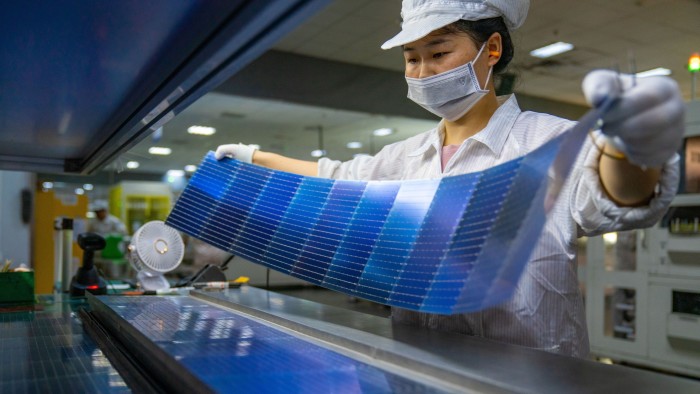Chinese diplomats will arrive in Azerbaijan with a message for the UN COP29 climate conference. In the “real world”, they will argue, China is racing ahead of schedule in its efforts to decarbonise its economy. It is also helping the developing world do the same via its booming renewable energy and electric vehicle industries, as well as its Belt and Road infrastructure initiative.
Chinese officials, meanwhile — in line with recent discussions with diplomats and other foreign visitors — are expected to push back at moves from Washington and Brussels that link negotiations over climate change to Beijing’s industrial policy and trade practices. They will also be increasingly assertive in highlighting China’s efforts to finance the green transition in the developing world, despite western calls for Beijing to be more ambitious.
And, with COP29 opening after Donald Trump’s US presidential election win, expectations that the country will withdraw from the Paris agreement on climate change have been raised.
Li Shuo, an analyst of Chinese climate and energy policy, says global climate diplomacy is at risk of becoming “more politicised, more divisive” and drifting to “a rather irrelevant status” because of the US government’s insistence on linking climate and trade issues.
“China’s impressive success when it comes to embracing the low-carbon economy . . . is not a political story but a ‘real economy’ story,” argues Li, director of the China Climate Hub at the Asia Society Policy Institute think-tank. “Which part of the world wins that ‘real economy’ competition?”
Beijing’s growing confidence in climate diplomacy marks a significant change after years of pressure from western leaders, who have argued that the world’s biggest polluter — accounting for about a third of global emissions — needs to act more quickly to help the world tackle global warming.
Several statistics point towards China’s decarbonisation efforts outstripping Beijing’s expectations, and progressing towards the dual goals of peak emissions before 2030 and carbon neutrality before 2060 that President Xi Jinping announced four years ago. Beijing achieved its target of having 1,200 gigawatts of installed solar and wind capacity — enough to power hundreds of millions of homes annually — in July, six years early. The government’s original goal of electric vehicles to account for half of car sales by 2035 is on course to be achieved next year.
At the same time, China’s foreign direct investment outflows are tracking at record levels. They are underpinned by cleantech investments in the developing world and supported by one of Xi’s hallmark foreign policies, the Belt and Road, which Beijing is now refocusing on green investments.
China’s emissions could even fall this year: CO₂ output in the third quarter hovered around last year’s levels and declined in the previous three months, according to an analysis by UK-based climate news site Carbon Brief.
This reflects, in part, both the surge in low-carbon electricity generation in China, which is home to about two-thirds of the world’s solar and wind power projects under construction, and transport sector electrification. It also raises the possibility that China’s total emissions peaked in 2023 — seven years ahead of Xi’s 2030 target.
But Lauri Myllyvirta and Chengcheng Qiu, the Carbon Brief report’s authors and analysts at the Finland-based Centre for Research on Energy and Clean Air, say there is “uncertainty” over the chances of a year-on-year emissions decline, following new economic stimulus plans announced by Beijing in September. The authors point out that policymakers are cautious about claiming emissions have already peaked.
International experts also question whether Beijing is doing enough to wean the country off coal, given signs of a resurgence in the pace of coal-fired power station builds and the slow rate of retirement of older coal-fired plants.
A report from Global Energy Monitor, an environmental research group, says China’s coal industry sits at a “pivotal juncture”, with a recent surge in production prompting a “significant threat to the country’s dual carbon goals”.
Xuyang Dong, a China energy policy analyst at Climate Energy Finance, an Australian think-tank, argues that China’s renewable electricity generation, backed by huge investment in the power grid and energy storage, means coal will increasingly only be used as an emergency back-up before, “inevitably”, being phased out.
However, with relations between many western capitals and Beijing at a historical low point, China’s green revolution could have other effects. Distrust of China among western countries is widespread, so some might slow their own climate transition to resist using low-cost green technologies from China. Washington and Brussels are highly critical of Beijing’s alleged unfair state support for its cleantech industries.
Domestically, however, Xi’s dual carbon pledges, known as shuang tan, have fundamentally shifted the focus of officials across the country, experts say.
Jingbo Cui, co-director of the Environmental Research Center at Duke Kunshan University, near Shanghai, says the shuang tan policy has sparked intense competition between provincial and city governments in China.
Officials have raced to set more ambitious carbon emissions and intensity-reduction targets, while vying for investment from new cleantech industries. There has also been stricter regulatory oversight of heavy industry, aimed at reducing industrial pollution.
Cui adds that there is a sense among officials, experts and industry that, as the direction has been set by Xi, they are safe to debate openly how to achieve the policy goals. This contrasts with other issues in China, including aspects of the economy, where criticism of policies can be considered politically sensitive.
“Before this shuang tan policy, the pressure was on [economic] development — that is it,” Cui says. “After the policy, there is this dual pressure. On the one hand, you still have development. On the other, you have to target to really cut down emissions and intensity.”
Read the full article here

